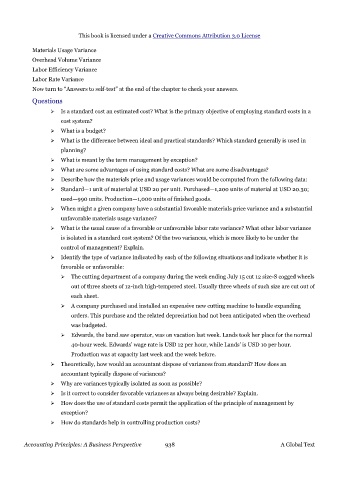Page 937 - Accounting Principles (A Business Perspective)
P. 937
This book is licensed under a Creative Commons Attribution 3.0 License
Materials Usage Variance
Overhead Volume Variance
Labor Efficiency Variance
Labor Rate Variance
Now turn to “Answers to self-test” at the end of the chapter to check your answers.
Questions
➢ Is a standard cost an estimated cost? What is the primary objective of employing standard costs in a
cost system?
➢ What is a budget?
➢ What is the difference between ideal and practical standards? Which standard generally is used in
planning?
➢ What is meant by the term management by exception?
➢ What are some advantages of using standard costs? What are some disadvantages?
➢ Describe how the materials price and usage variances would be computed from the following data:
➢ Standard—1 unit of material at USD 20 per unit. Purchased—1,200 units of material at USD 20.30;
used—990 units. Production—1,000 units of finished goods.
➢ When might a given company have a substantial favorable materials price variance and a substantial
unfavorable materials usage variance?
➢ What is the usual cause of a favorable or unfavorable labor rate variance? What other labor variance
is isolated in a standard cost system? Of the two variances, which is more likely to be under the
control of management? Explain.
➢ Identify the type of variance indicated by each of the following situations and indicate whether it is
favorable or unfavorable:
➢ The cutting department of a company during the week ending July 15 cut 12 size-S cogged wheels
out of three sheets of 12-inch high-tempered steel. Usually three wheels of such size are cut out of
each sheet.
➢ A company purchased and installed an expensive new cutting machine to handle expanding
orders. This purchase and the related depreciation had not been anticipated when the overhead
was budgeted.
➢ Edwards, the band saw operator, was on vacation last week. Lands took her place for the normal
40-hour week. Edwards' wage rate is USD 12 per hour, while Lands' is USD 10 per hour.
Production was at capacity last week and the week before.
➢ Theoretically, how would an accountant dispose of variances from standard? How does an
accountant typically dispose of variances?
➢ Why are variances typically isolated as soon as possible?
➢ Is it correct to consider favorable variances as always being desirable? Explain.
➢ How does the use of standard costs permit the application of the principle of management by
exception?
➢ How do standards help in controlling production costs?
Accounting Principles: A Business Perspective 938 A Global Text

